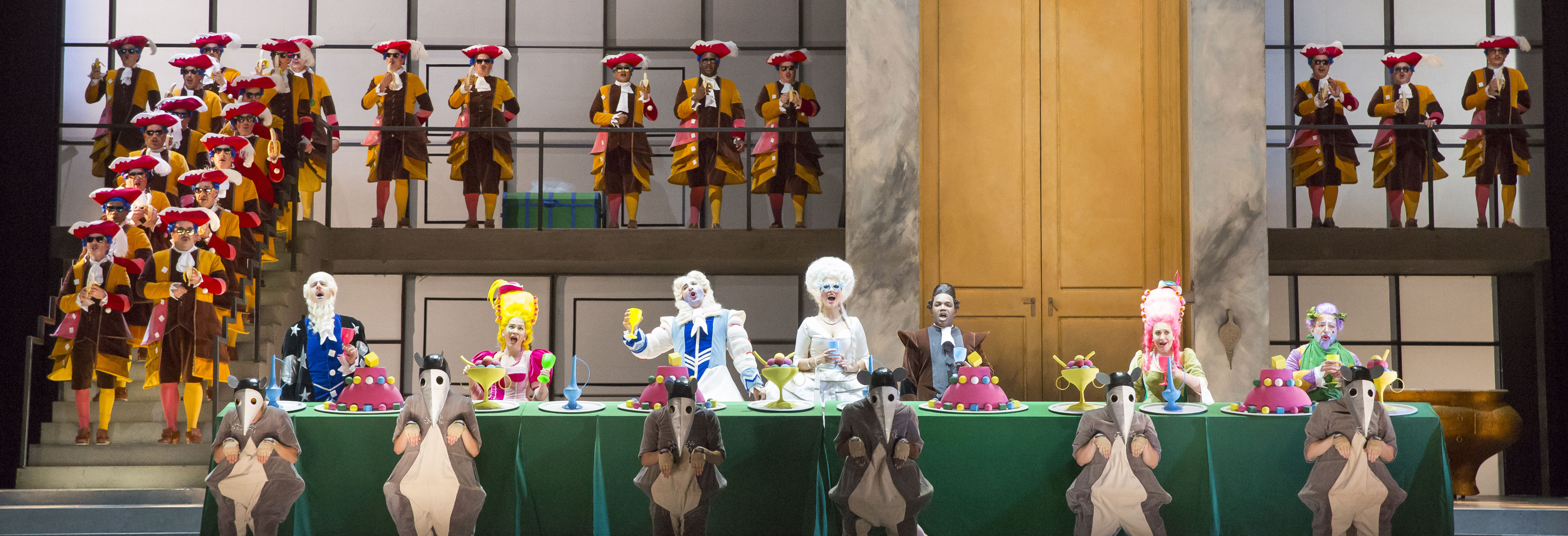November 10, 2020
Rossini: composing the perfect meal
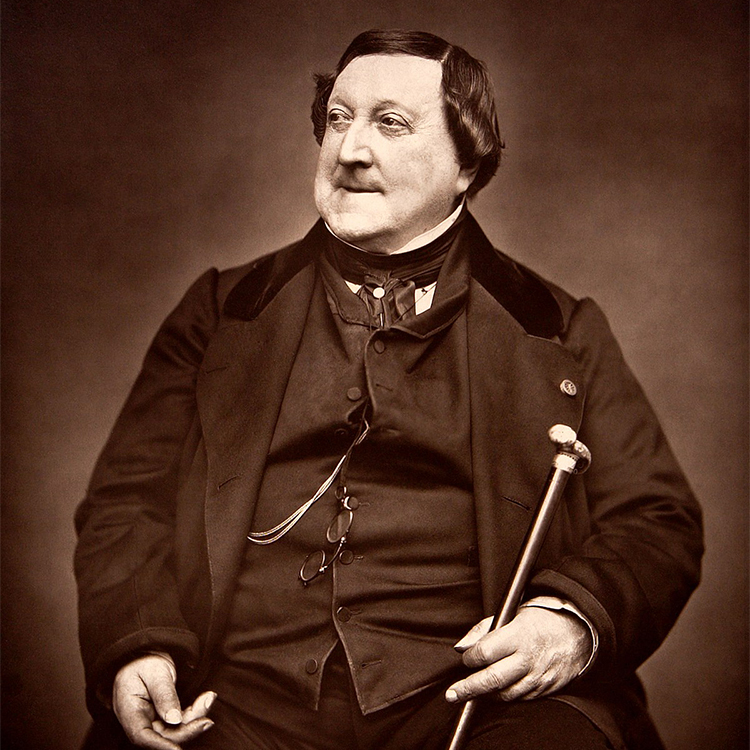
Gioachino Rossini is one of opera's most beloved composers—writing 39 operas in his first 37 years, including The Barber of Seville, La donna del Lago, and William Tell. However, after the premiere of William Tell, Rossini abruptly retired from composing to pursue his second passion—food.
He spent the rest of his life—40 years!—as a celebrated gourmand. As one of the top foodies of the day, he was a close friend of noted Parisian chef Antonin Carême, who he met while studying in Paris. The two of them had a unique version of a pen-pal correspondence: Carême would send Rossini pâté or another specialty item, and Rossini would reply with a short aria as thanks.
Rossini's culinary reputation grew so large that the phrase "alla Rossini"—most often signifying some combination of liver, foie gras, and truffles in a dish—became appended to creations by many chefs, including the famous Tournedos Rossini preparation of filet mignon.
Try indulging in some of these rich Rossini-inspired recipes! As the composer himself once said, "I know of no more admirable occupation than eating."
Tournedos Rossini

In this most famous of all Rossini-named dishes, filet mignon is accompanied by truffles, foie gras, and a very rich sauce. Try it yourself with this recipe from Leites Culinaria:
For the sauce
- 2/3 cup Madeira
- 2 tablespoons minced shallot
- 1 thyme sprig
- 1/2 bay leaf
- 2 cups veal or beef stock
- 1 1/2 teaspoons arrowroot or cornstarch, mixed with 1 1/2 teaspoons water (optional)
- 1 to 2 tablespoons cold unsalted butter
- 3/4 teaspoon kosher salt, plus salt to taste
- Freshly ground black pepper, to taste
- 1/2 teaspoon red wine vinegar
- 1/2 to 1 ounce fresh or preserved black winter truffle
For the medallions
- Four 4-ounce filet of beef (tenderloin) medallions, about 1 1/2 inches thick, at room temperature
- Kosher salt and freshly ground black pepper, to taste
- 2 tablespoons vegetable oil
- Four 1-ounce grade-A or -B duck foie gras medallions
Make the sauce
In a saucepan, bring the Madeira, shallot, thyme, and bay leaf to a gentle simmer and cook until the wine is reduced to a light syrup coating the shallots. The wine may flame briefly but will go out just as quickly.
Carefully pour the stock into the wine reduction and gently simmer until reduced by half. Skim any impurities that rise to the surface. (If the sauce isn't thick enough to coat the meat, whisk the arrowroot mixture into the sauce and bring to a full boil to thicken.) Reduce the heat to low and whisk in the butter. Season with the 3/4 teaspoon salt, the pepper, and vinegar. Slice the truffle paper-thin with a truffle slicer, mandoline, or very sharp knife and add to the sauce. Set aside and keep warm, preferably in a double boiler over hot water, for up to 1 hour. (You may need to adjust the consistency with a bit of water if the sauce thickens.)
Make the medallions
Meanwhile, pat the beef medallions dry with paper towels and season one side of the meat with salt and pepper. Heat a heavy skillet over low heat. Add the oil to the pan, increase the heat to medium-high, and place the meat, seasoned-side down, in the pan. Sauté until the steaks are a rich, burnished brown on the bottom, about 4 minutes. Season the remaining side with salt and pepper to taste, turn, reduce the heat slightly, and brown the other side, 3 to 4 minutes. Brown the sides of the medallions by standing them on their sides. Transfer the meat to a plate.
Wipe out the skillet and return it to medium-high heat. Season the foie gras medallions with salt and pepper to taste. Add the foie gras medallions to the skillet and cook for 1 to 2 minutes, or until a deep brown on the bottom. Drain off any excess fat. Turn the foie gras with a metal spatula and cook for 30 seconds to 1 minute, or until the foie gras softens but still has some resilience. Transfer to paper towels to drain.
Assemble the plate
To serve, remove any strings from the beef medallions. Place the beef on warmed plates or a platter. Top with the foie gras and nap with the sauce, making sure that a couple slices of truffles rest on each serving of foie gras. Serve immediately.
Maccheroni (macaroni) alla Rossini
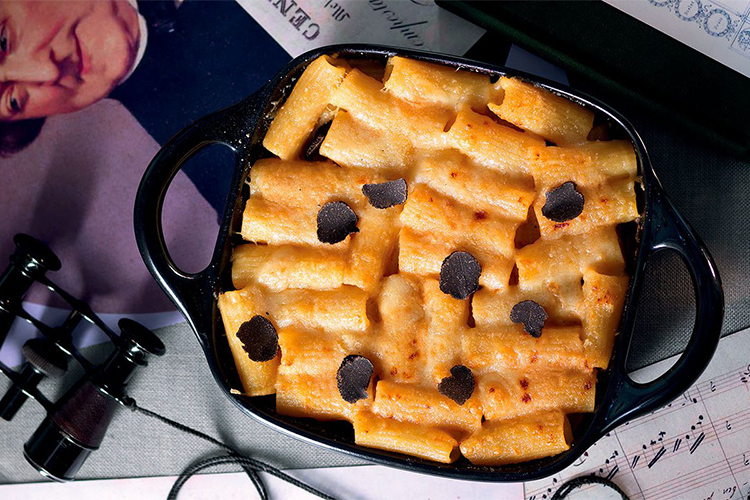
This rich baked pasta is layered with mushrooms, truffles, and ham in a tomato-champagne-cream sauce. Fun fact: in the composer's original recipe, flat pasta sheets (such as lasagna noodles) were used instead of a short tube pasta. Try it for yourself with this recipe adapted from La Cucina Italiana:
Ingredients
- 8 oz rigatoni pasta
- 1 cup fresh cream
- ½ cup dry-cured ham
- ⅓ cup black truffle
- ¼ cup dried porcini mushrooms
- 1 tomato, diced
- 1 cup grated Parmesan cheese
- 1 cup Gruyère cheese
- 2 orange peels
- 3/4 cup Champagne
- ¼ cup breadcrumbs
- 4 cups broth
- 8 tbsp butter
- 1 tsp salt
- 1 tsp pepper
- ¼ tsp nutmeg
- ¼ tsp ginger
- ¼ tsp cloves
- ½ tsp thyme
- ½ tsp rosemary
- 1 bay leaf
Make the sauce
In a saucepan, add 4 tbsp of butter, ⅓ cup of Parmesan cheese, 1 cup of broth, dried mushrooms (soaked and squeezed), half of the truffles (chopped), ½ cup chopped ham, spices, herbs, 1 diced tomato, ½ cup of cream and ¾ cup of Champagne.
Cook for at least 1 hour over low heat to obtain a liquid sauce. Strain out the solids, adjust the salt, and keep it warm. If the sauce is too thin, thicken it to taste with a teaspoon of cornstarch dissolved in a little cream.
Make the pasta
Boil the rigatoni pasta gently in the remaining broth enriched with ½ cup of cream and 2 orange peels. Drain when it reaches "al dente" and toss with the prepared sauce.
Assemble the dish
Grease an oven-safe casserole dish and spread the macaroni in alternating layers with layers of Parmesan cheese, Gruyère cheese, and small cubes of butter. Finish with the cheese, butter, and breadcrumbs and bake in the oven at 350° F for 15 minutes. Remove from the oven and serve with the rest of the sliced truffle (serves 4).
Coupe Rossini
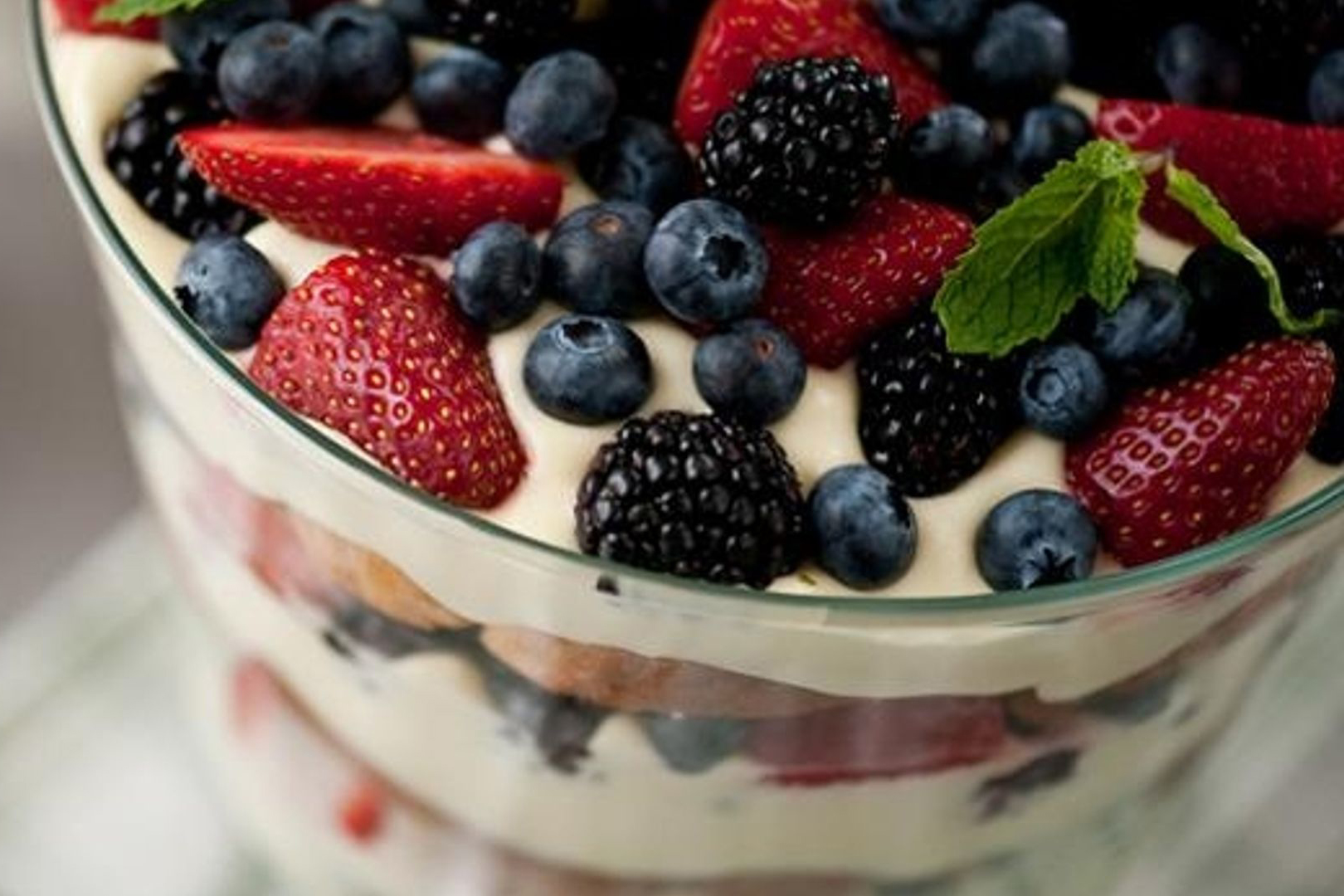
Created by the San Francisco Opera for their 2005 opening night gala, this dessert pays tribute to the composer with a rich mascarpone mousse paired with delicious fresh berries. We think Rossini would have approved. Try it for yourself with this recipe from Food Network:
Ingredients
- 1 cup heavy cream
- 2 teaspoons powdered sugar
- 2 ounces mascarpone
- 1 teaspoon pure vanilla extract
- 2 cups strawberries
- Granulated sugar
- 4 ladyfingers
- 1 cup blueberries
- 1 cup raspberries
- 1 cup blackberries
- 4 scoops strawberry sorbet
- 4 chocolate cigarettes (optional)
- 4 puff dough pencils (optional)
- 4 white chocolate rings (optional)
- 4 mint tips (optional)
In a mixer using the whisk attachment, beat cream and slowly add powdered sugar and mascarpone. Add vanilla and beat until fairly stiff. Set aside.
Slice the strawberries and use half the amount to make a coulis (a thin sauce) in the blender with granulated sugar, to taste. Set aside.
To assemble the dessert, line up 4 lowball red wine glasses. Break each ladyfinger into 4 pieces and place the pieces into each glass. Next, pour 1/4 of the coulis into each glass. Place the remaining sliced strawberries over the ladyfingers and coulis. Place the mascarpone cream mixture into a pastry bag and make a solid layer of cream in each glass. Then place the blueberries, raspberries, and blackberries, dividing evenly, over the cream. When ready to serve, garnish with the sorbet, and the optional finishing touches: chocolate cigarettes, puff dough pencils, white chocolate ring, and mint tip.
Rossinis
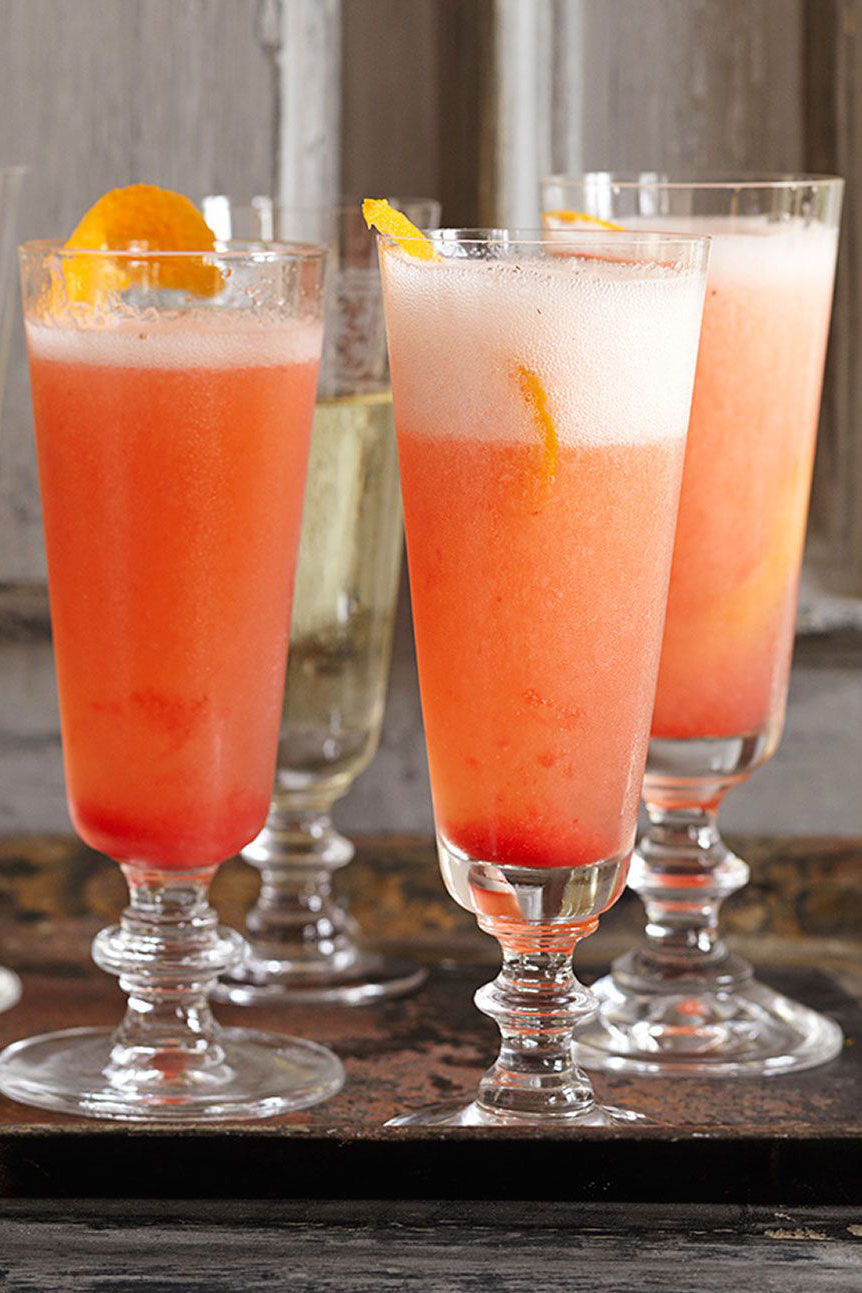
A delightful take on the Bellini, featuring strawberries (instead of the traditional peaches) paired with prosecco and Grand Marnier. Try it for yourself with this recipe from Ina Garten:
Ingredients
- 1 pint (2 cups) ripe strawberries, hulled
- 2 1/2 tablespoons sugar syrup
- 1 teaspoon Grand Marnier liqueur
- 6 orange zest strips, for garnish
- 1 (750-ml) bottle Prosecco, chilled
Place the strawberries in the bowl of a food processor fitted with the steel blade and puree until completely smooth. Pour the liquid through a fine-mesh sieve and press to make a seedless puree. Discard the seeds. Add the sugar syrup and Grand Marnier to the puree and refrigerate until very cold.
When ready to serve, rub the rim of each Champagne glass with the orange zest. Pour the cold Prosecco into Champagne glasses until they're each three-quarters full. Carefully stir 2 tablespoons of the puree into each glass and serve very cold. (Makes 6-7 drinks)
To learn more about Rossini's prolific but brief composing career and lengthy retirement, read this excellent New York Times article by Zachary Woolfe from 2011.
